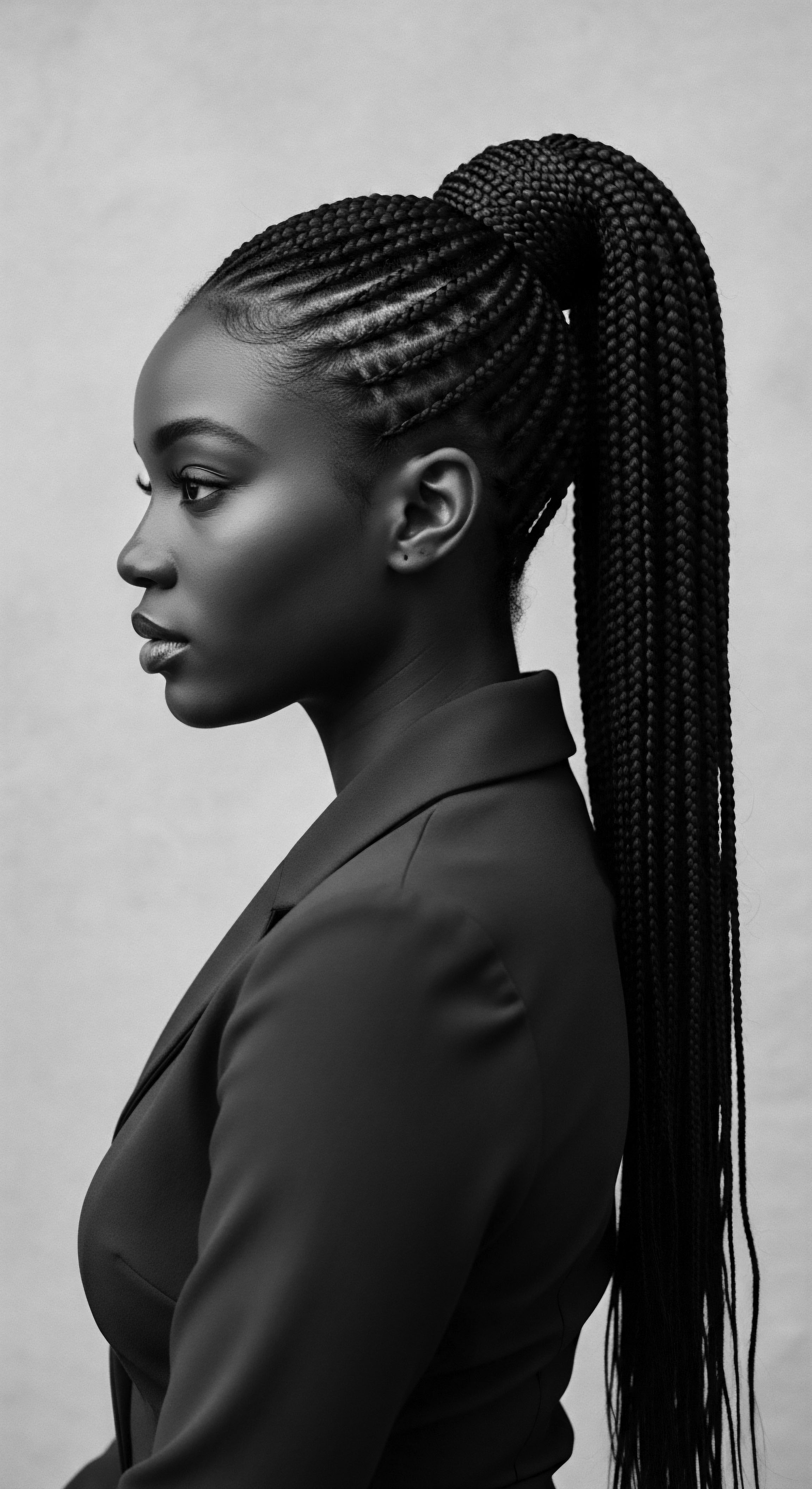The whisper of ancient winds through history’s leaves brings forth tales of textured hair, a crown of identity for countless generations. For those whose hair speaks in coils and kinks, in waves and spirals, the stories woven into each strand are not merely biological accounts; they are living archives of heritage , resilience, and ingenuity. Our exploration of how ancient combs supported textured hair growth delves into this profound connection, seeking to understand the ingenuity of our forebears, whose wisdom laid the groundwork for hair care practices that echo even today. This is a journey through time, a meditation on how simple tools became extensions of cultural expression, aiding the flourishing of hair that defies easy categorization, celebrating its inherent strength and beauty.

Roots
In the quiet corners of history, long before industrial tools shaped our routines, the relationship between human hands, natural materials, and the glorious complexity of textured hair was a sacred bond. For individuals with coily and tightly curled hair, the act of grooming was not merely about appearance; it was a deeply ingrained practice, a conversation with the self and with lineage. Ancient combs, often crafted with a deep reverence for the materials they sprang from, served as conduits in this conversation. These tools, varying from simple wide-set picks to intricately carved pieces, were designed with an intuitive understanding of hair structure, promoting both health and intricate styling.
Their shapes and tooth spacing spoke volumes, reflecting a knowledge passed down through generations, attuned to the unique characteristics of hair that curls back upon itself, creating its distinctive volume and spring. This fundamental understanding of textured hair’s needs shaped the very earliest tools.

What Characterizes Textured Hair at Its Core?
To truly grasp the significance of ancient combs, we must first recognize the biological blueprint of textured hair itself. Unlike straight hair, which tends to have a round or oval cross-section, coily and kinky hair often exhibits a flattened, elliptical cross-section, which contributes to its characteristic curl pattern. This unique morphology also influences how sebum, the scalp’s natural oil, travels down the hair shaft. On straighter strands, sebum glides effortlessly, providing lubrication.
For textured hair, the twists and turns impede this journey, often leaving the ends drier and more susceptible to breakage. This inherent dryness, alongside the hair’s natural inclination to coil, means textured hair is more prone to tangles and knots. A deeper understanding of this fundamental biology reveals the foresight embedded in ancient grooming practices.
The fundamental understanding of textured hair’s unique structural needs shaped the development of ancient grooming tools.
The ancestral approaches to hair care were not haphazard; they reflected a profound observation of hair’s behavior. The tools were fashioned to work in harmony with the hair’s natural state, prioritizing gentleness and preservation. This contrasts sharply with later periods that saw attempts to force textured hair into Eurocentric ideals through harsh methods.
The combs of antiquity were not about altering the hair’s nature, but about honoring and maintaining it, ensuring its vitality. They were designed to minimize friction and breakage, allowing the hair to retain its strength and length.

Historical Hair Morphology and the Comb’s Design
Archaeological evidence from ancient Kemet, present-day Egypt and Sudan, reveals combs dating back over 5,500 years. These early combs, often made from materials like Wood, Bone, or Ivory, frequently featured wide-spaced teeth, a design exceptionally suited for navigating the coils of textured hair. Petrie (1920, p. 58) suggested that longer-toothed combs found in ancient Egypt might have been used for holding coils of hair in place, while shorter-toothed examples were for general combing, indicating an awareness of different functionalities.
This thoughtful spacing was crucial. Fine-toothed combs, while effective for straight hair, would snag and tear through coiled strands, causing damage. The broader gaps of these ancient instruments allowed them to glide through dense, coily textures, gently separating strands without causing undue stress or breakage. This intentional design protected the hair cuticle, maintaining its integrity and reducing the likelihood of split ends, factors directly supporting healthier growth. The very act of slow, deliberate combing with such tools could also have aided in the distribution of natural oils from the scalp, a process often hindered by the unique structure of textured hair.
The materials chosen for these combs also played a significant role. Natural woods, often dense and smooth, offered a non-abrasive surface that was kind to the hair shaft. Unlike modern plastic, which can generate static electricity and lead to frizz and breakage, wood is an insulator. This property meant that ancient combs could reduce static, contributing to smoother, more manageable hair.
This gentle interaction fostered an environment where hair could grow unimpeded by mechanical damage, preserving its length and overall vitality. The preservation of hair length, often a challenge for textured hair due to its delicate nature and shrinkage, was a silent testament to the efficacy of these tools.
Beyond their practical application, these combs held symbolic value, often buried with their owners, signifying their importance in both life and the afterlife. This suggests that hair care, and the tools associated with it, were intertwined with identity and spiritual well-being within these ancient societies. The deliberate crafting of these combs, often with carved symbols reflecting tribal identity, rank, or spiritual beliefs, elevates them from mere grooming implements to profound cultural artifacts.

Ritual
The rhythmic motion of a comb through textured hair, particularly in ancient times, transcended simple grooming. It was a ritual, a communal act, a moment of connection that bound individuals to their families, their communities, and their ancestral practices. The ways in which ancient combs influenced styling and were central to these traditions reflect a profound understanding of hair’s cultural significance and its potential as a canvas for expression. This ritualistic aspect of care, deeply ingrained in the daily lives of ancient peoples, contributed significantly to the health and vitality of textured hair.

How Did Ancient Styling Practices Incorporate Comb Use?
Ancient African societies, in particular, utilized combs as a fundamental tool in creating the elaborate and symbolic hairstyles that characterized their cultures. Hairstyles were not merely aesthetic choices; they communicated age, marital status, clan affiliation, and even spiritual beliefs. The wide-toothed comb was essential for preparing the hair for these intricate designs, gently detangling and separating strands to create the foundation for braids, twists, and other sculptural forms. Without such tools, the delicate process of working with dense, coily hair would have been far more damaging.
Consider the practice of protective styling , a cornerstone of textured hair care both ancient and contemporary. Styles like braids, cornrows, and various forms of locs (dreadlocks) have deep roots in African heritage. These styles minimized daily manipulation, shielding the hair from environmental elements and reducing breakage, thus allowing for length retention.
Ancient combs were indispensable in creating these styles, facilitating clean parts, smoothing strands, and ensuring an even tension that respected the hair’s integrity. The combs enabled the precise sectioning required for intricate braiding patterns, allowing for styles that could last for extended periods, further supporting hair growth by reducing daily stress.
| Ancient Materials Wood (e.g. mahogany, olive wood) |
| Properties Beneficial for Textured Hair Smooth, anti-static, gentle on cuticles, aids oil distribution. |
| Modern Parallels / Insights Modern wide-tooth wooden combs continue to be favored for detangling and minimizing static. |
| Ancient Materials Bone (e.g. animal bone) |
| Properties Beneficial for Textured Hair Durable, smooth surface when polished, often used for strength. |
| Modern Parallels / Insights Limited modern use, but historical examples highlight adaptability and resourcefulness. |
| Ancient Materials Ivory |
| Properties Beneficial for Textured Hair Smooth, prestigious, allowed for fine carving; though ethically problematic today. |
| Modern Parallels / Insights Once a symbol of status, now recognized for its historical artistry, not its material. |
| Ancient Materials Horn (e.g. ox horn) |
| Properties Beneficial for Textured Hair Keratin-based, similar to hair protein; does not generate static electricity. |
| Modern Parallels / Insights Prized in some holistic hair care circles for natural properties and static reduction. |
| Ancient Materials Ancient artisans thoughtfully selected materials, understanding their direct impact on hair health and style longevity, a wisdom that continues to inform modern practices. |
A specific historical example demonstrating the profound connection between ancient combs and textured hair heritage lies in the Dogon people of Mali . Their elaborate hairstyles, often requiring hours of communal effort, were deeply tied to their cosmology and social structure. Combs made from wood or iron were not merely tools but artifacts of this shared experience, used to shape hair into intricate patterns that could signify everything from age-grade initiation to spiritual devotion.
The very architecture of their hairstyles, with their distinct partings and sculpted forms, would have been impossible without the precise and gentle action of appropriately designed combs, preventing the breakage that would compromise such long-term styles. These styles, once established, protected the hair from daily environmental damage, allowing it to grow undisturbed.

Communal Grooming and the Comb’s Significance?
The act of hair grooming often took place in communal settings, becoming a social activity where stories were shared, wisdom imparted, and bonds strengthened. The comb, therefore, acted as a silent participant in these intergenerational exchanges. Younger generations learned from elders not only the techniques of using the comb but also the cultural meaning embedded within each stroke.
This shared practice contributed to the consistent application of beneficial hair care habits. The ritualistic nature meant that detangling and styling were likely approached with patience and care, avoiding the hasty actions that lead to hair damage.
Communal hair grooming, guided by the ancestral comb, was a vital social practice where intergenerational wisdom was exchanged, reinforcing cultural identity.
The design of many ancient African combs reflects this dual purpose ❉ utilitarian and symbolic. Decorations of animals, human figures, or geometric patterns were not simply adornments; they held spiritual or social meaning. This meant that each comb, even in its daily use, served as a constant reminder of one’s identity, community, and ancestral roots. Such deep cultural meaning surely reinforced the respectful handling of both the hair and the tool, contributing to practices that inherently supported hair health and, by extension, its growth.

Relay
The enduring legacy of ancient combs extends beyond their initial application, influencing contemporary understanding and practices in textured hair care. This continuity represents a relay of wisdom, a transfer of knowledge across millennia that still holds relevance in our modern world. Our ancestors intuited many principles that science now validates, particularly concerning hair growth and scalp health. The careful design of ancient combs, rooted in a deep understanding of textured hair’s unique needs, laid foundational methods for detangling, stimulating, and protecting strands, all crucial for healthy growth.

How Do Ancient Comb Principles Align with Modern Hair Biology?
The structure of coily and kinky hair, characterized by its helical twists and often irregular cross-section, makes it inherently more fragile and prone to breakage than straight hair. Each curve in the strand is a potential point of weakness where mechanical stress can lead to fracture. This explains why gentle handling is paramount for textured hair to retain length. Ancient combs, particularly the wide-toothed varieties common in African civilizations for thousands of years, were designed precisely to minimize this stress.
By having ample space between the teeth and often rounded tips, they reduced snagging and pulling, allowing for a smooth passage through the hair. This gentle mechanical action directly correlates with modern understanding of preserving the hair’s keratin structure. When hair is treated with minimal friction, its cuticle layer remains smoother, better protecting the inner cortex. A compromised cuticle leads to moisture loss and increased susceptibility to damage, hindering growth.
Moreover, the act of combing with these tools, when performed with care, also contributed to scalp health. Scalp stimulation is a recognized factor in promoting healthy hair growth. Gentle massage increases blood circulation to the hair follicles, ensuring a robust supply of oxygen and nutrients essential for the anagen (growth) phase of the hair cycle. The deliberate, unhurried rhythm of ancient grooming rituals, aided by the smooth, often wooden or bone combs, naturally provided this therapeutic massage.
This stimulation, far from being an aggressive act, was a nurturing one, contributing to a healthy follicular environment. As early as the Sui Dynasty, physicians recognized that regular hair combing led to benefits like reduced hair loss and improved hair quality, even suggesting combing 100 times before sleep for calm and rest.

Ancestral Solutions for Hair Longevity?
One striking example of ancestral foresight is the widespread use of wide-toothed combs to address detangling, a critical step for textured hair. African American women today often find anecdotal success with finger detangling and wide-tooth combs due to the fragility of kinky hair, especially when wet (Knight & Long, 2017, p. 5). This reinforces the historical prevalence and effectiveness of wide-tooth implements.
The careful removal of tangles, before they could become matted or lead to significant breakage, directly supported length retention. This was not about forcing hair into submission; it was about respectfully guiding it, allowing its natural form to remain undisturbed while ensuring its health. Ancient cultures understood that consistent, gentle detangling was a cornerstone of maintaining hair that could grow long and strong. This focus on preservation over alteration speaks to a deep, intuitive hair science.
The choice of materials also played a part in promoting hair longevity. Wooden combs, in particular, are known to distribute the scalp’s natural oils (sebum) evenly along the hair shaft. This natural oiling helps to moisturize the hair, preventing dryness that makes textured hair particularly vulnerable to breakage. The gentle, non-static glide of wood ensures that these protective oils reach the ends, providing a natural coating that seals moisture and protects against environmental stressors.
This holistic approach, integrating the tool with the body’s natural processes, exemplifies the wisdom of ancestral care. The legacy of these practices is seen in the continued advocacy for wooden combs in modern natural hair communities.
Beyond individual care, archaeological findings consistently demonstrate the reverence afforded to hair and its tools. For instance, combs unearthed in Kush and Kemet, dating back thousands of years, were often buried with their owners. This practice highlights that these instruments were more than just utilitarian items; they were objects imbued with profound cultural and personal significance, likely reflecting a lifelong dedication to hair care as part of identity and well-being. This societal valuing of hair maintenance implicitly reinforced practices that would promote its health and growth.
Ancient combs, particularly the wide-toothed designs, were pivotal in preserving textured hair’s delicate structure, reducing breakage, and stimulating scalp health, aligning with modern hair science.
The materials employed for ancient combs often reflected localized resources, leading to variations in design and properties.
- Palm Wood Combs ❉ Utilized in regions where palm trees were abundant, these combs offered durability and a smooth finish suitable for minimizing friction on sensitive hair types.
- Animal Bone Combs ❉ Crafted from the bones of local fauna, these tools were carefully smoothed and shaped, representing a resourceful and sustainable approach to tool making within ancestral communities.
- Carved Horn Combs ❉ From various animal horns, these combs offered a natural keratin surface that was highly compatible with human hair, contributing to less static and smoother detangling.
These localized variations underscore a global understanding of hair care specific to available natural elements, with universal principles of gentleness and efficiency remaining central to their design.

Reflection
As we close this contemplation on ancient combs and their kinship with textured hair, a profound truth settles within ❉ the whispers of the past are not distant echoes but living currents shaping our present. The ingenuity of our ancestors, their deep attunement to the rhythms of nature and the wisdom held within each strand, continues to guide us. These simple combs, crafted from wood, bone, or horn, were more than mere implements; they were extensions of a philosophy that revered the hair as a sacred part of the self, a connection to lineage, identity, and the very spirit of life. They supported textured hair growth not through harsh intervention, but through a gentle reverence, minimizing disruption and maximizing its natural vitality.
This heritage of care reminds us that our hair is not simply a biological marvel; it is a profound library, holding within its coils and kinks the stories, struggles, and triumphs of those who came before us. To understand the ancient comb is to recognize a continuous story of resilience, beauty, and unwavering self-acceptance.

References
- Petrie, W. M. F. (1920). Prehistoric Egypt. British School of Archaeology in Egypt.
- Knight, S. M. F. & Long, W. (2017). Narratives of Black Women on Hair in the Workplace. Psychology in Society, 54, 1-19.
- Girish, K. (2008). Neem ❉ A Versatile Tree. Narosa Publishing House.
- Quartey, G. A. (2021). The Versatility of Neem Tree. Lambert Academic Publishing.
- Baby, A. R. (2022). Neem ❉ From Traditional Medicine to Modern Uses. Nova Science Publishers.
- Ashton, S. A. (2013). The Afro Comb ❉ A Cultural History of Hair. Fitzwilliam Museum.
- Patton, T. D. (2006). Breaking the Chains ❉ Slavery, Race, and the Urban Body. University of Minnesota Press.
- Lester, N. (2000). The New Black Hair Revolution. Simon & Schuster.
